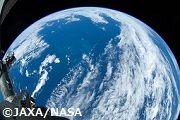| タイトル | 日出入時刻計算における標高の効果について |
| その他のタイトル | On the effects of dip and refraction in calculating the times of sunrise and sunset |
| 著者(日) | 相馬 充 |
| 著者(英) | Soma, Mitsuru |
| 著者所属(日) | 国立天文台 |
| 著者所属(英) | National Astronomical Observatory of Japan |
| 発行日 | 2001-09-28 |
| 発行機関など | 国立天文台
National Astronomical Observatory of Japan |
| 刊行物名 | 国立天文台報
Report of the National Astronomical Observatory of Japan |
| 巻 | 5 |
| 号 | 3 |
| 開始ページ | 91 |
| 終了ページ | 95 |
| 刊行年月日 | 2001-09-28 |
| 言語 | jpn |
| 抄録 | 天体の出は山麓より山頂の方が早く、天体の入りは山頂の方が遅い。天体の出入りは標高が高くなるほど見かけの水平線が鉛直線に垂直な方向より下がって見える。この下がって見える角度を眼高差という。国立天文台編による理科年表および海上保安庁水路部による天体位置表においては、両者ともに日の出および日の入り時刻に対する標高による効果の計算が間違っている。この論文はこの点を明らかにし、この効果の正しい計算式を示すことを目的とした。始めに幾何学的眼高差について述べた。標高の日出入時刻に対する効果Δtは、理科年表1986、1989、1996年版に与えられている。ここでは、大気による光の屈折を無視した場合の公式を、天の北極・天頂・水平線上の出入り点を頂点とする球面3角に球面3角の公式を適用して導いた。大気屈折を考慮した場合のΔtの式はここで導出した式よりも小さくなることはない。しかし、理科年表に与えてある式は導出した式より小さくなっており、明らかに誤りである。次に、Smartによる眼高差の求め方に従って、大気中の光の屈折を考慮した場合の、眼高差や日出入時への補正量を求めた。ここで求めたものは地平大気差以外に必要な補正量である。理科年表や天体位置表における誤りは、補正量として、地平大気差と眼高差しか考慮していないところにある。その他、過去の理科年表その他における標高補正について述べた。
A celestial body rises faster on the top of a mountain top than at the foot and sets later at a mountain top than at the foot of the mountain. In the rising and setting of a celestial body, the higher the elevation is, the lower the apparent horizon appears than the perpendicular direction to a vertical line. This angle of apparent lowering is called the dip of the horizon. In the Chronological Scientific Tables of the Rika Nenpyo edited by the National Astronomical Observatory and in the Japanese Ephemeris published by Japan Coast Guard, the formulae of effects of elevation on the times of sunrise and sunset are incorrect. This paper aims to clarify this fact and give correct formulae for the effects. At first, the geometrical dip of the horizon is described. The effects of an elevation on the times of sunrise and sunset, denoted delta-t, were given in the 1986, 1989 and 1996 editions of the Rika Nenpyo. In this paper, the expression in case of neglecting the refraction of light in the air was derived using the spherical trigonometric formulae for the spherical triangle, of which vertices are the north celestial pole, the zenith, and the sunrise or sunset point on the horizon. The expression of delta-t taken into account of the refraction of light is not expected to be smaller than that derived here. But the expression given in the Rika Nenpyo is smaller than that derived here, indicating that the expression in the Rika Nenpyo is obviously wrong. Next, according to the method of Smart for the dip of horizon, corrections to the dip of the horizon and to the times of sunrise and sunset in case of taking into account of the refraction of light in the air were obtained. The correction obtained here is the necessary one other than the correction of horizontal atmospheric refraction. The causes of errors in the Rika Nenpyo and in the Japanese Ephemeris are that they didn't include anything but the correction of the horizontal atmospheric refraction and the dip of the horizon. In addition the elevation correction found in the past Rika Nenpyo etc. are also described. |
| キーワード | sunrise time; sunset time; elevation effect; dip of the horizon; horizon; refraction; spherical triangle; horizontal atmospheric refraction; 日出時刻; 日入時刻; 標高効果; 眼高差; 水平線; 屈折; 球面3角; 地平大気差 |
| 資料種別 | Technical Report |
| ISSN | 0915-6321 |
| SHI-NO | AA0029435003 |
| URI | https://repository.exst.jaxa.jp/dspace/handle/a-is/34452 |
|

